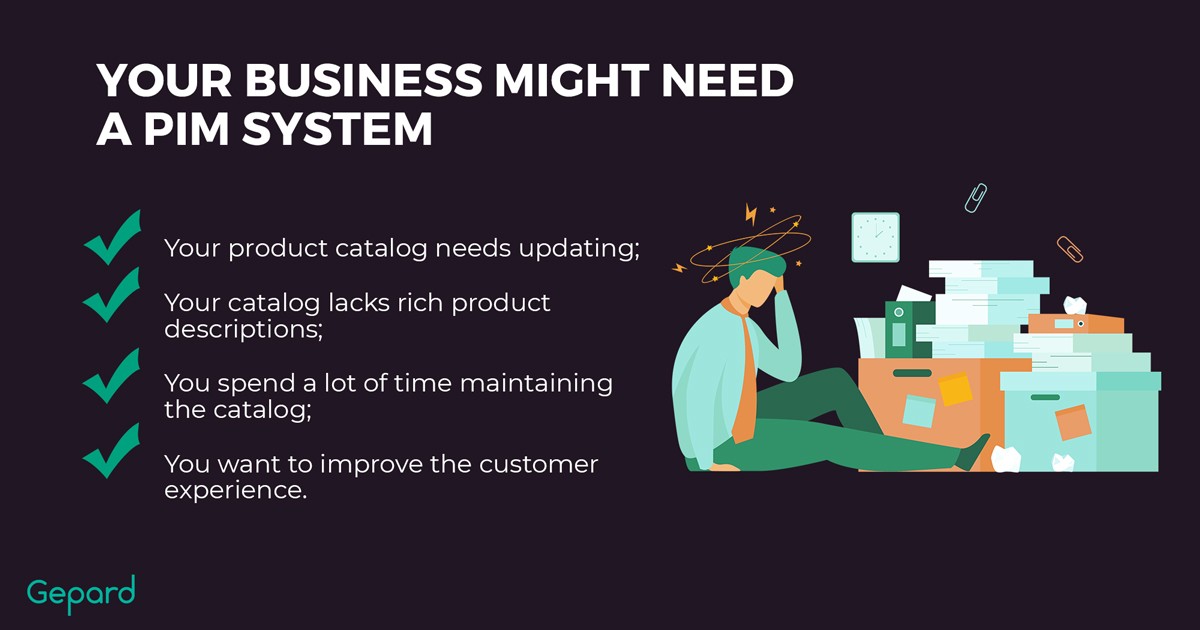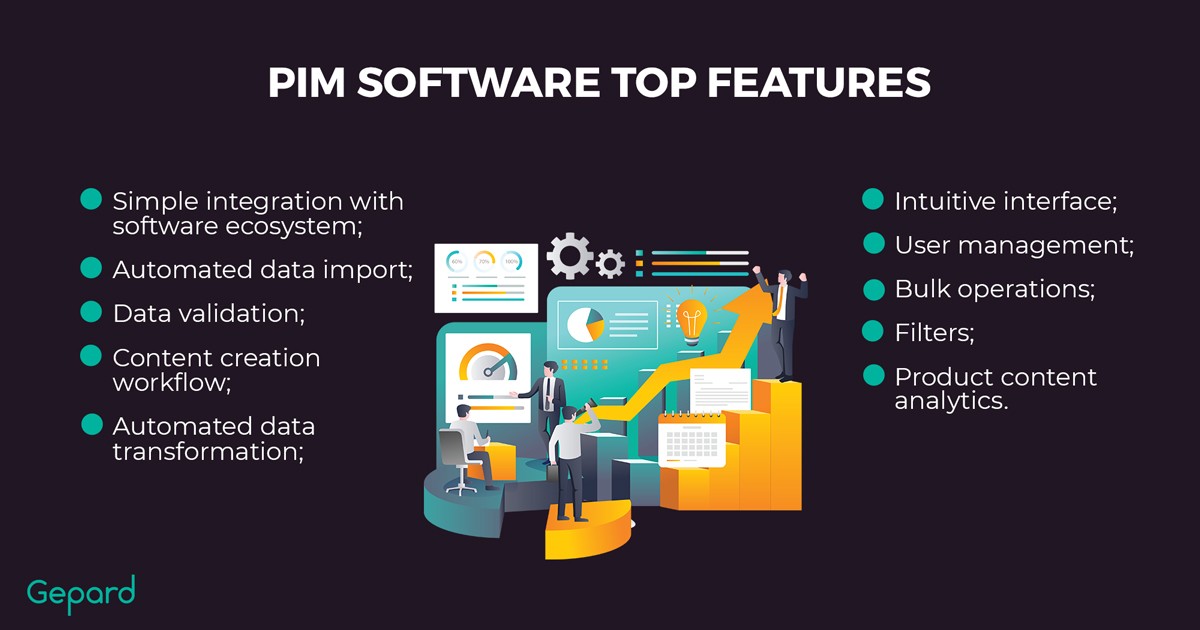Successful PIM Strategy: How To Plan Yours In 7 Steps
What could be so complex about implementing a PIM tool strategy? Choose an app, install it, and start using it. “That’s all” – you can say.
Not so fast!
If you take this process lightly, you may well be losing time on a product that doesn’t suit your business needs. So let’s explore what a good PIM strategy is and find out the steps to implementing it.
What Is PIM Strategy?
What are the main product information management strategy steps?
- Defining your strategy goals.
- Defining your product content needs.
- Identifying who will be involved in your PIM plan.
- Assessing the future PIM system requirements.
- Choosing the right system.
- Implementing the system.
- Ensuring continuity.
Before we get into the details, let’s see how completing these steps can benefit your business.
The Benefits Of A PIM Strategy
So, implementing a PIM tool isn’t an obvious deed and takes several steps to complete. But, what’s the advantage of that? For one, breaking the task into smaller increments will help you yield better results once a solution is in place. At the end of this process, your shop’s life will become much easier as you will acquire a single source of truth to improve customer experience and automate product data distribution.
Let’s overview the main benefits of implementing a PIM strategy for brands and retailers.
For brands:
- Better product data management. As your catalog grows, the system makes it easier to keep track of information about new items, as well as any changes in the old assortment.
- Better customer experience. With information management software, you’ll be able to make new items available faster and provide the most accurate information.
- Data syndication. While all your product data is stored in your PIM, you can easily distribute it to other platforms and conform to the different requirements e-market platforms constitute.
- Data validation. A good PIM platform will generate reports on missing data, so you can make sure that your catalog is complete and useful to customers.
- Retailer-specific requirements. You’ll be able to tailor the details about your goods directly in the tool without having to create the catalog from scratch or risk losing data.
For retailers:
- Data standardization. If you have information coming from several brands or manufacturers, most of it is likely organized differently. The product information management software, on the other hand, allows you to create a uniform catalog based on all the sources.
- Data collection. You can automate the process of mapping and gathering information and save time on manual labor.
- Data enrichment. It allows you to enrich the content you have gathered with quality, improve SEO, and improve the overall experience a customer can have with your shop.
- Time efficiency. Such systems reduce the amount of time you and your team spend on data entry and tailoring information from different brands to specific requirements.
- Better relations with suppliers. The tool can help you better organize all the documents coming from various brands.
How to Develop a Successful PIM Strategy For Your Business
Now that you know this business strategy is more than handy for brands, manufacturers, and retailers, let’s move on to outlining the seven steps to creating one.
1 Step: Define The Goals Of Your PIM Strategy Based On Business Needs
The first and the most deciding factor of your success is understanding your end goals – what PIM system implementation should accomplish for your business. This step may also require a meeting with everyone involved with content to determine the goals which are usually targeted at satisfying certain needs.
Here are a few examples of such needs:
- Your product catalog may need updating. If it’s uncategorized or lacks current data, or you don’t even know the state it’s in – all of these reasons are a no-go for modern eCommerce businesses.
- Your catalog lacks rich product descriptions. Another no-go is offering customers weak info that doesn’t reflect the true value of your goods.
- You spend a lot of time maintaining the catalog. Automation is essential for businesses that want to keep up. A PIM system helps reduce the amount of time you spend editing, improving, and distributing information about your goods.
- You want to improve the customer experience. A benefit that rich product information gives is improving the experience people have when shopping with you. However, using a system also ensures that buyers get the most up-to-date information, which is critical if you have a lot of items and sell on more than one platform.

2 Step: Define Product Content Needs For Your PIM Plan
What kind of information does your catalog provide? This could be the core marketing copy, technical specifications, rich media, reviews, certification – any data that you already have or want to add to your catalog.
This is an essential step because you need to know if the system in question can manage all your data types. Furthermore, you might have a digital asset, in which case you need your PIM content to integrate with DAM (Digital Assets Management) software.
3 Step: Identify The Players Involved In The PIM Strategy
Unless you’re a sole entrepreneur, there is more than one person in your company involved with product content:
- Marketing managers – they are responsible for the content that advertises your assortment. They can also advise on the specific text and visuals needed to promote your goods.
- eCommerce specialists – they oversee all aspects of your sales strategy, as well as conversions.
- Content managers – they are responsible for managing and distributing information about your goods in a PIM and across your shops and marketplaces.
- Brand managers – they are responsible for how customers perceive your shop and products.
Category managers – they are responsible for specific categories of goods that you sell.
Aside from these positions, there may be other product data experts on your staff who can manage or affect the data inside your software. And let’s not forget the buyers – their opinion directly affects your catalog.

4 Step: Assess Your Resources And Set Requirements For Your Future PIM System
Having identified everyone involved in your company’s PIM process, it’s good to interview each specialist. So, draw a list of questions that will gauge info about the needs and challenges of all your content specialists.
What kind of questions should you ask? They can be about the tools they use, how much time certain tasks take, and what would improve product data management in their opinion.
After collecting feedback and analyzing it, you should get a list of prerequisites that can improve your workflow. Take them as essential features of your future software.
5 Step: Choose The Right Product Information Management System For Your Business
Your company might have a different set of needs than any of your competitors has. But with the variety of systems, one of them will likely cover all or most of your needs.
Here are the top ten features that you can find in modern PIM software:
- Simple integration with software ecosystem – such systems integrate with various eCommerce web apps, allowing you to syndicate product information to the most popular ones without a hitch.
- Automated data import – such software takes away the manual labor, reducing the number of potential mistakes and improving the information quality.
- Data validation – you can generate reports about your catalog to know if there are any gaps or missing information. This will help you check the accuracy of data and clean out outdated specifics.
- Content creation workflow – it’s the steps your team needs to take to fill up your catalog with data, from gathering details to publishing them to marketplaces. A product information management platform helps define the roles and stages in this process.
- Automated data transformations for retailers – since the marketplaces and store websites you use are likely to have different formats, a PIM system transforms the data to fit the format automatically.
- Intuitive interface – meaning an app that works as you would expect and that you won’t have to study rigorously before using. You can use a good PIM system with minimal onboarding.
- User management – there are different roles in product information management, and good software will allow you to define them, as well as tailor access permissions for different users.
- Bulk operations – you can perform certain actions in bulk, like syndicating a catalog to several platforms at once.
- Filters – you can categorize the goods in your catalog for easier management.
- Product content analytics – the software can help you analyze the content to identify what can be improved or altered.

6 Step: Implement A Product Information Management System
Once you have identified all parties involved, and figured out what conditions the system must fulfill and what features may help with that, it’s time to start the integration process. It entails the identification of sources and end-points of data, learning your and how it will interact with a PIM, and lastly, understanding what your tool’s output should be.
You can learn more about the integration process or use our roadmap from the article “Implementing Product Information Management System: Roadmap To PIM.”
7 Step: Ensure Process Continuity
Congrats! You’ve implemented a solution that undoubtedly improves product information workflow and saves you a lot of time by automating related processes.
But only if you and all parties involved keep using it.
So, the PIM plan doesn’t stop at installation and data-to-PIM import. The next stage is ensuring continuity and that your employees use the system to reap maximum benefit.
Product Information Management Strategy FAQ
What Are Product Information Management Strategy Best Practices?
There are several PIM best practices, that you can implement. If you want the process to run smoothly, it’s best to start by defining the goals that you’d like to achieve with such a system in place. Then, identify the specialists involved in managing product details, their needs, as well as the features you need in a PIM to satisfy these requirements. Only then it’s fair to choose and install a system.
Who Can Provide The Best PIM Software Solution?
Let’s start with the fact that the best software is the one that suits your needs. And if you’re looking for a reliable provider, you can start by trying out Gepard PIM – you might not need to look any further.
Where To Start If I Want To Create A PIM Strategy For My Company?
Start by figuring out why you need it and what business task it can solve. This will affect the success of your implementation strategy in terms of gaining expected results.
You can then proceed to define who will be involved in the process and what resources you already have. This helps understand the team’s needs and, thus, requirements for the software.
With such information in hand, you can choose a system that’s most suitable for your business.
Get Your Product Information Management Strategy On The Roll
If you want to improve product information management in your company and provide a better shopping experience for your customers, developing a PIM strategy is a must. And once you have a strategy in place, choose a reliable piece of software like Gepard PIM.
Our PIM platform covers the most essential eCommerce needs when it comes to information management and more. We also provide professional support during the implementation.
Sounds like a plan? Then contact us for a free demo.


